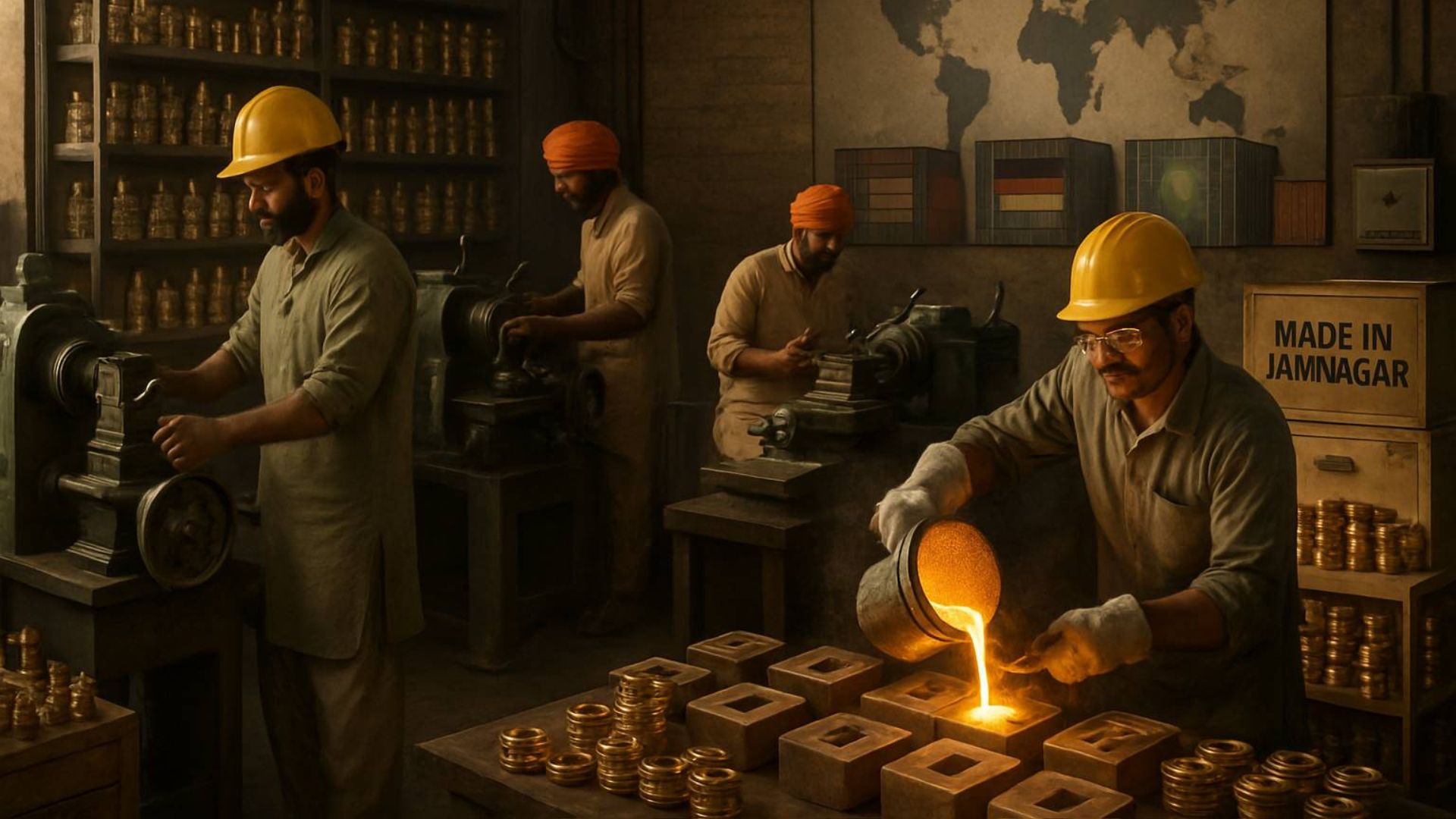When you hear the word “Jamnagar,” a place in Gujarat, what comes to your mind? For most of the people, Reliance Industries comes to their minds, but it is not the only thing that we should remember Jamnagar for.
Jamnagar also has a fascinating story that the majority of Indians don’t know about. “Jamnagar” is known as the Brass Capital of the World. We should remember Jamnagar as a story of 7000+ MSMEs, a story of brass scraps turned into global precision components, and a story that built an INR 40,000 crore empire without raising a single rupee from venture capital.
Jamnagar should be highlighted because the city was built by local manufacturers, family-run workshops, and generations of metalworkers who turned Jamnagar into the Brass Capital of the World.
Jamnagar manufactures the crucial components that are needed for auto, electric, aerospace, stationary, hardware, and other sectors both in India and overseas, constituting over 40 countries.
To give you the context of why Jamnagar is considered the Brass Capital of the World, let’s look at the numbers. As per the brass export data, India exported $1122.53 million worth of brass during the April and July of 2023-24. It is a rise of 30.99% from the year before.
But now we need to understand what exactly they do. In terms of brass parts manufacturing, what do they actually do, and why is the world depending on us?
“So, what exactly happens inside Jamnagar’s brass units?”
The manufacturing ecosystem of Jamnagar starts with raw material such as brass scrap, which is essentially a mix of copper, zinc, and traces of lead. This scrap is usually sorted and segregated based on the different grades of brass and contaminants.
In the next step, sorted scrap is melted in furnaces at extremely high temperatures. During this stage, manufacturers adjust the alloy composition by adding lead for machinability or other trace elements depending on client specifications. The molten metal is then poured into ingots, rods, or billets, which become the raw shapes for various components. These are sent for casting, forging, or extrusion, depending on the final product’s complexity, whether it’s a plumbing valve, an electrical connector, or a gas fitting.
This is followed by polishing, plating (like nickel or chrome), and finishing, giving the parts corrosion resistance and aesthetic quality. After final quality checks and packaging, the components are exported across the globe.
Here we need to understand the concept in depth: The first step is sourcing raw materials. India sources brass scrap from different countries, almost 80% from the USA and the remaining 20% usually from other countries such as Africa, Germany, etc.
The main raw materials required are brass scrap and lead. These are essential to manufacture the intricate components. This is a major problem for the manufacturers, as the prices of raw materials fluctuate a lot. Any global tension or geopolitical issue will harness the industry. After that, all the remaining processes go in flow and export the final products.
But now the real question is, why Jamnagar? Why not another city or place in India?
There are multiple advantages and benefits for Jamnagar:
- Access to Ports and Global Exports: Jamnagar is located near Kandla and Mundra ports, two of the busiest shipping gateways in India. This logistical advantage enables simple import of raw materials (primarily brass scrap from the U.S., Germany, and African nations) and export of finished components to over 40 countries with minimal delays and reduced freight costs.
- A Centuries-Old Legacy: The roots of brass manufacturing in Jamnagar date back to the early 20th century, when local artisans started working with metal for utensils and utility goods. Over generations, these skills were refined, modernized, and turned workshops into micro-industries and craftsmen into precision engineers.
- Cluster-based Manufacturing: This city operates like a closed circuit, and every stage of brass manufacturing is handled by specialized units just in different streets. This helps in reduced logistics costs, turnaround times, and flexibility for unmatched orders.
- Internal Ecosystem: Jamnagar has its own internal ecosystem for tool and die making, casting mold design, surface treatment chemicals, quality inspection labs, and custom packaging units.
Over the years, the Gujarat government has supported Jamnagar’s brass industry with dedicated brass parks, subsidies for exports, and incentives for pollution control technologies.
So, when the whole ecosystem is available at a single place, it is very beneficial for both seller and buyer. They can manufacture the product within the budgets and can thrive with profits.
Now you might have this question where do we really use these products, and who are their customers, right?
Brass components are everywhere; for example, in the automotive industry, we use them in fuel nozzles, brake parts, sensors, bushings, and fittings.
In electrical and electronics, we use it in terminal blocks, connectors, switch parts, sockets, and plugs.
In plumbing, we use it in valves, faucets, pipe fittings, and couplings. Even in aerospace and defense, we use it in precision connectors, instrumentation parts, and mounting hardware.
So, there are multiple applications for the components that are being manufactured here.
In an interview, the president of the Jamnagar Factory Owners Association stated that Hero Honda, Maruti Udyog Limited, Prestige Cooker, Bajaj Auto, Anchor Switches, and many other global and domestic players depend on Jamnagar for these brass components manufactured in Jamnagar.
So, it clearly shows a demand for the product and how India is winning and dominating the space.
But what is the key takeaway?
We don’t really need great PR and huge marketing budgets if our product is really needed for the world.
Have you heard of any of the industries spending crores for marketing or raising billions? But they are silently driving the whole world just by manufacturing the tiny components.
Indian startups and entrepreneurs should idealize businesses like these because they don’t scream for attention, they don’t trend on social media, and we don’t even hear any of the names. But still, every time we switch on a light, turn on a tap, or drive a car, there’s a connection with Jamnagar.
Also Read: The Secret Behind India’s Booming Fintech Industry: What’s Fueling the Growth








